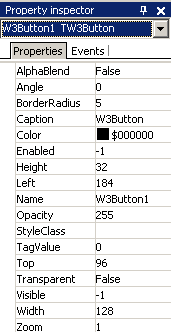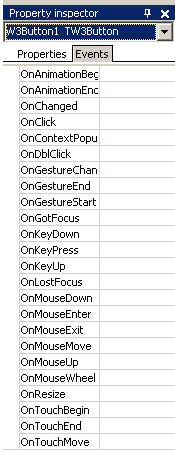The units of the VJL - visual component library are many (and growing) – the heart of the system is really only made up of 3 central files. When you get to know these and what they do everything else will fall into place. So let’s have a look.
|
SmartCL.System |
||||||||||||||||||||||||||||||||||
|
Low level SmartCL.System.Types As the name implies this unit is all about low level functionality and the system, which in our case is the document object model. In many ways this unit is a blend between system and sysutils under delphi, here you will find functions for creating, interacting with and obtaining information directly from html entities (all controls are pure javascript under Smart. We don’t map our javascript onto a prefabricated design). This is also the home for common utility functions, data-type declarations and record types. The only real difference between the sysutils under delphi and w3system under VJL, is that we have isolated common utility functions into their own name-space (as class functions), making everything more organized and easier to work with. So TVariant contains all the variant functions, TRect all the functions for manipulating rectangles – and so on.
TInteger = class W3system is also home to our browser drivers. When you execute your application, the application begins by checking what browser you are using – and initializes a driver for it (note: drivers are written in smart, there are no external dependencies involved in this). By using drivers we manage to handle advanced techniques, such as hardware accelerated graphics and transformations, from a common code-base. Any peculiarities are handled by the driver and the rest of the RTL don’t have to worry about it.
If the idea of drivers sounds like overkill for something as trivial as a web app, we must remember that there are subtle but important differences between browsers. For instance webkit browsers favours "length" as a property in some javascript objects – but mozilla favours "size". Through the drivers we are able to keep vendor specific clutter to a bare minimum. |
||||||||||||||||||||||||||||||||||
|
SmartCL.Components |
||||||||||||||||||||||||||||||||||
|
Widgets - SmartCL.Components This unit is where visual controls are first introduced. The most fundamental class which implements the mechanism for self creation, attaching itself to – and detaching itself from another element, is TW3tagobj. From this basic object the following hierarchy is built: TW3component TW3Movablecontrol TW3Customcontrol Just like the object hierarchy in delphi, from TWinControl to TCustomcontrol, each descendant adds specific behavior and properties to the model it has inherited.
Smart Mobile Studio Property Inspector TW3component adds the ability to house child components. It also introduces the familiar delphi component constructor, which takes an owner component as a parameter. Properties: public
TW3Movablecontrol adds properties like left, top, width and height (and associated methods like moveto, setbounds, etc.) and thus allows you to move an element around. This class was added between TW3component and TW3Customcontrol to provide a lightweight alternative for game and multimedia programmers. It is especially suited as a "sprite" (see unit w3sprites) which can be manipulated in both 2d and 3d via the built in Sprite3d engine (see w3sprite3d). Properties: public
TW3Customcontrol is the class all visual controls inherit from. It inherits the full richness of methods and properties from it’s ancestors, but adds sub-objects like background, font, border management, size restriction, CSS style management and scroll information. These sub objects are created on demand, so unless you access these from your code they remain dormant. TW3Customcontrol is also the class that introduces support for gestures, touch and multi-touch – and all the events standard html entities expose. Depending on the entity a TW3Customcontrol represents, some events may not fire. For instance, if the control represents a html5 canvas the onScroll event will naturally never fire. Since there is a limited number of events under the DOM TW3Customcontrol publishes all of them. Properties: public |
||||||||||||||||||||||||||||||||||
|
Go to Event JS Reference.
See more DOM JS Reference.
|
||||||||||||||||||||||||||||||||||
|
SmartCL.Controls |
||||||||||||||||||||||||||||||||||
|
Toolkit - SmartCL.Controls This unit contains the standard visual controls that ship with Smart Mobile Studio. It is a great unit to inspect if you want to learn how to create your own custom controls (which is much easier than it sounds). You will notice that the controls all override one method in particular: makeElementTagObj. This function (implemented in TW3tagobj as a virtual method) is in charge of creating the actual html tag you want to work with. As of writing the unit contains the following visual controls (not counting sub controls or auxiliary classes)
|




